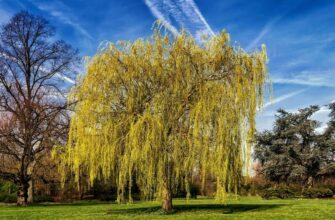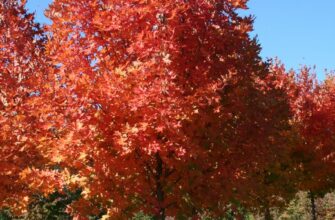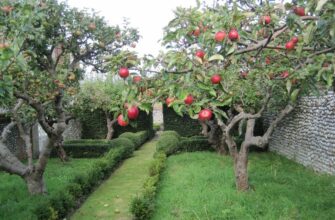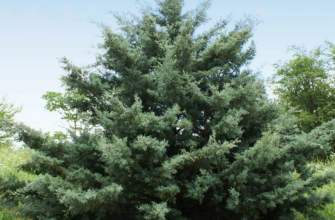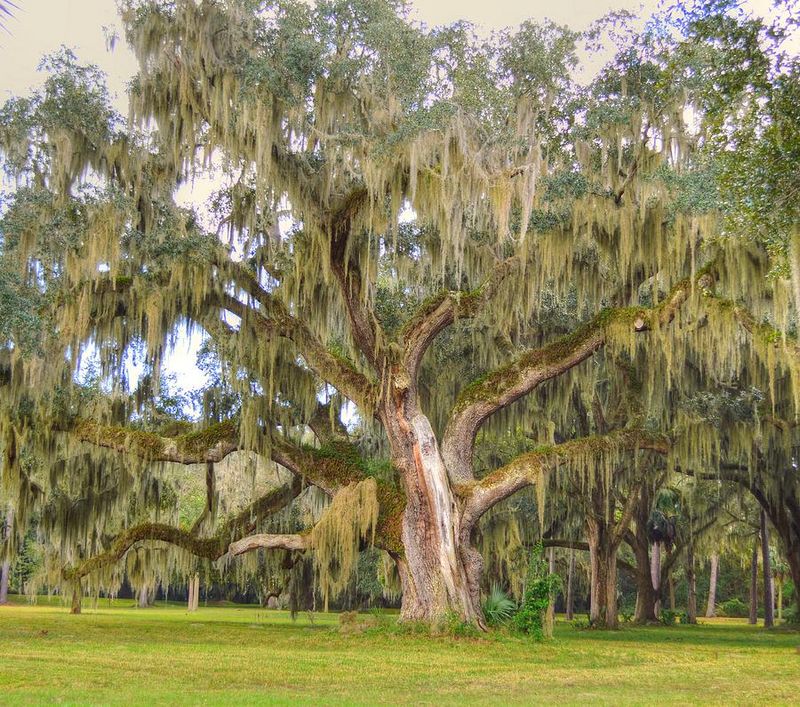
- America’s National Tree: The Mighty Oak
- The Importance of Oak Trees in America
- The Symbolism of Oak Trees
- History
- The Role of Oak Trees in Native American Cultures
- The Use of Oak Wood in American Colonization
- Characteristics
- The Majestic Size of Oak Trees
- The Long Lifespan of Oak Trees
- The Unique Leaf Structure of Oak Trees
- Ecosystem Benefits
- Oak Trees as Habitat for Wildlife
- The Role of Oak Trees in Carbon Sequestration
- Threats
- Climate Change and Oak Trees
- Pests and Diseases Affecting Oak Trees
- Conservation Efforts
- Protected Oak Tree Species in America
- Community Initiatives to Preserve Oak Trees
America’s National Tree: The Mighty Oak
The oak tree is a symbol of strength, endurance, and resilience. It is often referred to as the “mighty oak” due to its impressive size and longevity. In America, the oak tree holds a special place as the country’s national tree, representing the nation’s values of strength and stability.
With its broad canopy and deep roots, the oak tree stands tall and proud, providing shade and shelter for countless species of birds, insects, and mammals. Its sturdy trunk and branches have been used for centuries to build homes, furniture, and even ships. The oak’s wood is known for its durability and resistance to decay, making it a popular choice for construction.
America’s love affair with the oak tree dates back to the founding of the nation. The famous Charter Oak in Connecticut, for example, played a significant role in American history. It is said that the original charter of the colony was hidden within the hollow trunk of the oak tree to protect it from being seized by the British authorities.
“The oak tree is not only a symbol of strength and endurance, but also a reminder of our nation’s history and the values that we hold dear.”
Today, the oak tree continues to be a cherished and iconic part of the American landscape. From the majestic live oaks of the South to the towering white oaks of the Northeast, these mighty trees can be found in parks, forests, and neighborhoods across the country. They serve as a reminder of our nation’s rich natural heritage and the importance of preserving and protecting our environment.
In conclusion, the oak tree is more than just a tree. It is a symbol of America’s strength, resilience, and history. Its mighty presence and enduring beauty make it a fitting choice for the country’s national tree. As we continue to admire and appreciate these majestic trees, let us also strive to protect and care for them, ensuring that future generations can enjoy their splendor for years to come.
The Importance of Oak Trees in America
The oak tree is a symbol of strength and resilience in America. It is not only a majestic tree that adds beauty to the landscape, but also plays a crucial role in the ecosystem. Oaks are considered the national tree of America, representing the mighty spirit of the nation.
One of the key reasons for the importance of oak trees in America is their ecological significance. Oaks provide habitat and food for a wide variety of wildlife, including birds, squirrels, and insects. The acorns produced by oak trees are an important food source for many animals, helping to sustain their populations. Additionally, the large size and longevity of oak trees make them valuable for nesting and roosting sites for birds.
In addition to their ecological importance, oak trees have played a significant role in American history and culture. The wood of oak trees has been used for centuries in the construction of buildings, furniture, and ships. The durability and strength of oak wood make it highly desirable for these purposes. Oak trees have also been used symbolically in American literature and art, representing strength, endurance, and the pioneering spirit.
Furthermore, oak trees have important environmental benefits. They help to improve air quality by absorbing pollutants and releasing oxygen. The extensive root systems of oak trees also help to prevent soil erosion and stabilize the land. Additionally, oak trees provide shade, reducing the need for air conditioning and saving energy.
In conclusion, oak trees are of great importance in America. They are not only the national tree, but also play a vital role in the ecosystem, have historical and cultural significance, and provide important environmental benefits. Preserving and protecting oak trees is crucial for the well-being of both wildlife and people in America.
The Symbolism of Oak Trees
The mighty oak tree holds a special place in America’s national identity. It symbolizes strength, endurance, and resilience, making it a fitting representation for the nation and its people.
The oak tree’s towering height and robust branches evoke a sense of power and grandeur. It stands as a testament to the indomitable spirit of America, reminding us of the country’s ability to overcome challenges and thrive in the face of adversity.
Furthermore, the oak tree’s deep roots symbolize stability and grounding. Just as the roots firmly anchor the tree to the earth, America’s national values and principles provide a strong foundation for its citizens.
In addition to its physical attributes, the oak tree has a rich historical and cultural significance. It has been revered by various civilizations throughout history, often associated with wisdom, knowledge, and protection.
The oak tree’s acorns, which are a prominent feature of the tree, represent potential and growth. Just as the acorn contains the potential to grow into a mighty oak, America is a land of opportunity where individuals can fulfill their dreams and aspirations.
Overall, the symbolism of oak trees encompasses the core values and aspirations of America. It serves as a reminder of the nation’s strength, resilience, and potential for growth, making it a fitting choice for America’s national tree.
History
The oak tree holds a special place in American history and culture. It has been recognized as the national tree of America due to its strength, longevity, and importance in the country’s development. The mighty oak has played a significant role in shaping the nation’s history.
From the earliest days of European settlement in America, oaks were highly valued for their timber, which was used in the construction of ships, buildings, and furniture. The oak’s durability and resistance to decay made it an ideal choice for these purposes. As America grew and expanded, the demand for oak timber increased, leading to extensive logging of oak forests.
During the American Revolution, the oak tree became a powerful symbol of freedom and independence. The famous Liberty Tree, an elm tree in Boston, was a rallying point for colonists who opposed British rule. However, oaks were also associated with the British monarchy, as they were used to build British naval vessels. Despite this, the oak’s connection to liberty and strength prevailed, and it became an enduring symbol of America’s fight for freedom.
Today, the oak tree continues to hold a special place in American culture. It is often planted as a symbol of strength and endurance, and its majestic presence can be found in parks, forests, and even city streets across the country. The oak tree represents the resilience and determination of the American people, and its significance as the national tree of America is a testament to its importance in the nation’s history.
The Role of Oak Trees in Native American Cultures
The oak tree has played a significant role in the cultures of Native Americans throughout America’s history. These majestic trees, known for their strength and longevity, have been revered by Native American tribes for centuries.
One of the main ways in which oak trees have been important to Native American cultures is through their use as a source of food. The acorns produced by oak trees are rich in nutrients and have been a staple in the diets of many tribes. Native Americans would gather acorns and grind them into flour to make bread, porridge, and other dishes.
Not only were oak trees a source of sustenance, but they also held spiritual significance for Native American tribes. Many tribes believed that oak trees were sacred and had the power to connect them with the spiritual realm. They would hold ceremonies and rituals under the shade of these mighty trees, seeking guidance and protection from the spirits.
In addition to their practical and spiritual importance, oak trees were also used for their wood. Native Americans would craft tools, weapons, and shelters from the strong and durable oak wood. The wood was also used for carving intricate designs and symbols, which held cultural and religious significance.
The role of oak trees in Native American cultures cannot be underestimated. These trees provided food, shelter, and spiritual connection for many tribes across America. Today, oak trees continue to be a symbol of strength and resilience in Native American communities.
The Use of Oak Wood in American Colonization
The national tree of America, the mighty oak, played a crucial role in the early days of American colonization. The abundant availability and exceptional qualities of oak wood made it an essential resource for the settlers.
Oak wood was highly valued for its strength and durability, making it ideal for constructing ships, houses, and furniture. The dense and sturdy nature of oak made it resistant to rot and decay, ensuring that the structures built with it would withstand the harsh American climate.
The early colonists used oak wood to build their ships, which were vital for exploration, trade, and transportation. The oak planks provided the necessary strength and stability to withstand the rough seas and long voyages. These ships played a crucial role in establishing trade routes and facilitating the growth of the colonies.
In addition to shipbuilding, oak wood was also used extensively in the construction of houses and furniture. The settlers relied on oak beams and planks to build sturdy and long-lasting homes that could withstand the harsh weather conditions and provide protection from potential threats.
The versatility of oak wood extended beyond construction. The colonists also utilized oak for fuel, as it burned slowly and provided a steady source of heat. Oak bark was used for tanning leather, and the acorns were a valuable food source for both humans and livestock.
In conclusion, the national tree of America, the mighty oak, played a vital role in the early days of American colonization. Its strength, durability, and versatility made oak wood an invaluable resource for shipbuilding, construction, and various other purposes. The use of oak wood contributed significantly to the success and growth of the American colonies.
Characteristics
The mighty oak tree is a symbol of strength and endurance, which is why it has been chosen as America’s national tree. This majestic tree is known for its large size and impressive stature. It can reach heights of up to 100 feet and have a trunk diameter of 3 to 4 feet. The oak tree is also known for its long lifespan, with some specimens living for hundreds of years.
One of the most distinctive characteristics of the oak tree is its strong and sturdy branches. These branches spread out in all directions, creating a wide and imposing canopy. The leaves of the oak tree are also quite unique, with their lobed shape and vibrant green color. In the fall, these leaves turn a beautiful shade of red, orange, or brown, adding to the tree’s overall beauty.
The oak tree is also known for its deep and extensive root system. These roots anchor the tree to the ground and help it withstand strong winds and storms. The oak tree is a resilient species that can adapt to a variety of soil types and climates. It is often found in forests, parks, and residential areas, providing shade and beauty to its surroundings.
In addition to its physical characteristics, the oak tree also has cultural and symbolic significance. It has long been associated with strength, wisdom, and endurance in many cultures around the world. The oak tree has been used as a symbol of national pride and unity, representing the resilience and fortitude of the American people.
The Majestic Size of Oak Trees
The oak tree is a symbol of strength and endurance in America, and it is no wonder why it is the national tree. These mighty trees can be found all across the country, standing tall and proud, with their branches reaching towards the sky.
One of the most impressive features of oak trees is their size. They can grow to be quite large, with some reaching heights of up to 100 feet or more. The trunk of an oak tree is often thick and sturdy, providing a strong foundation for the rest of the tree.
Not only are oak trees tall, but they also have a wide canopy that can span 50 feet or more. This allows them to provide ample shade and shelter for animals and other plants beneath their branches. The leaves of an oak tree are typically large and broad, which helps to capture sunlight for photosynthesis.
Oak trees are known for their longevity, with some living for hundreds of years. They are slow-growing trees, but their strength and durability allow them to withstand harsh weather conditions and other challenges. Their deep root systems help them to anchor themselves firmly in the ground, providing stability and support.
In addition to their impressive size, oak trees also have a beautiful appearance. Their bark is often rough and deeply furrowed, adding to their majestic appeal. The leaves of an oak tree can vary in shape and color, with some being lobed and others being smooth-edged.
Overall, the majestic size of oak trees is a testament to their importance and significance in America. They are not only a national symbol but also a vital part of the ecosystem, providing habitat and food for a variety of wildlife. Their grandeur and strength make them a true marvel of nature.
The Long Lifespan of Oak Trees
Oak trees are not only the national tree of America, but they are also known for their mighty presence and long lifespan. These majestic trees can live for hundreds of years, making them a symbol of strength and endurance in the natural world.
The average lifespan of an oak tree can range from 200 to 300 years, with some species even living up to 500 years or more. This impressive longevity is due to the oak tree’s ability to adapt and withstand various environmental conditions.
One of the factors that contribute to the oak tree’s long lifespan is its slow growth rate. Oak trees take their time to grow, allowing them to develop strong and sturdy trunks that can withstand storms and other natural disturbances.
Additionally, oak trees have a remarkable ability to regenerate and recover from damage. They have the ability to produce new branches and leaves even after being severely pruned or damaged. This resilience ensures their survival and helps them continue to thrive for many years.
Furthermore, oak trees have a deep and extensive root system that allows them to access water and nutrients even in dry and nutrient-poor soils. This adaptability makes them well-suited to various habitats and helps them survive in challenging conditions.
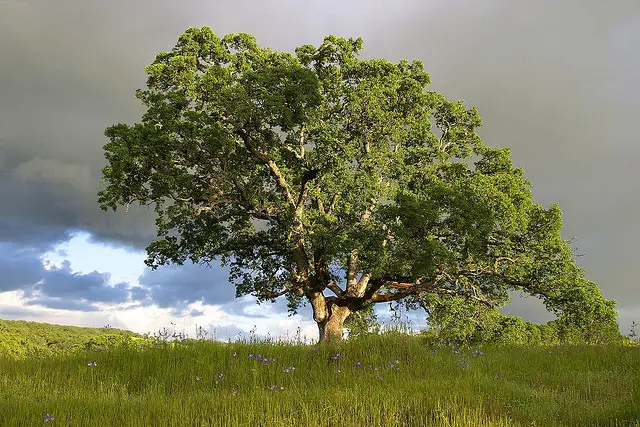
In conclusion, the national tree, the mighty oak, is not only admired for its grandeur but also for its long lifespan. Its slow growth rate, regenerative abilities, and deep root system are all factors that contribute to its impressive longevity. The oak tree serves as a reminder of the strength and resilience found in nature and continues to be a symbol of endurance for generations to come.
The Unique Leaf Structure of Oak Trees
The oak tree is a national symbol of America, representing strength and endurance. One of the most distinctive features of oak trees is their unique leaf structure.
The leaves of oak trees are typically large in size, with a length ranging from 2 to 12 inches. They have a broad, oval shape that tapers towards the tip and is widest near the base. This shape allows the leaves to capture the maximum amount of sunlight for photosynthesis.
What sets oak tree leaves apart is their lobed appearance. Most oak tree leaves have deep, rounded lobes that give them a distinct and recognizable shape. The number of lobes can vary depending on the oak species, with some leaves having as few as three lobes and others having up to 30.
The edges of oak tree leaves are often smooth, although some species may have serrated or toothed edges. This adds to the unique and diverse appearance of oak leaves.
In addition to their shape, oak tree leaves are known for their vibrant green color during the spring and summer months. As autumn approaches, the leaves undergo a stunning transformation, turning shades of red, orange, and brown before eventually falling to the ground.
Overall, the unique leaf structure of oak trees is not only visually appealing, but also serves a vital role in the tree’s survival and growth. By capturing sunlight and conducting photosynthesis, oak tree leaves contribute to the tree’s ability to produce energy and thrive in its environment.
Ecosystem Benefits
The mighty oak tree, which is the national tree of America, provides numerous ecosystem benefits. One of the most important benefits is its ability to absorb and store carbon dioxide, a greenhouse gas that contributes to climate change. As the oak tree takes in carbon dioxide through its leaves, it releases oxygen into the atmosphere, helping to improve air quality and reduce the effects of global warming.
In addition to its role in mitigating climate change, the oak tree also plays a crucial role in maintaining soil health. Its extensive root system helps to prevent soil erosion by holding the soil in place. The fallen leaves and branches of the oak tree also contribute to the organic matter in the soil, providing nutrients for other plants and organisms.
The oak tree is also a valuable habitat for a wide variety of species. Its large branches and dense foliage provide shelter and nesting sites for birds, squirrels, and other small mammals. The acorns produced by the oak tree are an important food source for many animals, including deer, turkeys, and rodents.
Furthermore, the oak tree has a symbiotic relationship with certain species of fungi. These fungi form a network of mycelium that connects the roots of the oak tree with other plants in the surrounding area. This network, known as the “wood-wide web,” allows for the exchange of nutrients and information between plants, enhancing their overall health and resilience.
Overall, the oak tree is a vital component of America’s ecosystems, providing numerous benefits that contribute to the well-being of both the natural environment and human society. Its ability to sequester carbon, maintain soil health, provide habitat, and foster symbiotic relationships make it a truly remarkable and important species.
Oak Trees as Habitat for Wildlife
The national tree of America, the oak, plays a crucial role in providing habitat for a wide range of wildlife species. Its large size and sturdy branches offer shelter and nesting sites for birds, squirrels, and other small mammals.
The dense foliage of oak trees provides a safe haven for many species of birds. They build their nests among the branches, using the leaves and twigs as materials. The height and strength of oak trees make them an ideal location for birds to raise their young, away from predators on the ground.
In addition to birds, oak trees also provide habitat for various insects and invertebrates. These creatures play a vital role in the ecosystem as they serve as food sources for other animals. For example, oak trees attract caterpillars, which are an essential food source for birds during their breeding season.
The acorns produced by oak trees are an important food source for many animals, including squirrels, deer, and turkeys. These animals rely on the high energy content of acorns to survive during the winter months when other food sources may be scarce.
The hollows and cavities that form in older oak trees provide shelter and nesting sites for bats, owls, and other cavity-nesting birds. These cavities offer a protected space for these animals to roost and raise their young.
Overall, oak trees are a vital component of the ecosystem, providing habitat, food, and shelter for a diverse range of wildlife species. Their presence in the landscape is not only aesthetically pleasing but also essential for maintaining biodiversity and supporting the balance of nature.
The Role of Oak Trees in Carbon Sequestration
Oak trees play a crucial role in carbon sequestration, making them an invaluable asset in America’s efforts to combat climate change. As one of the national trees of America, oaks are not only majestic and iconic but also highly effective in capturing and storing carbon dioxide from the atmosphere.
One of the reasons oak trees are so effective at carbon sequestration is their long lifespan. These trees can live for hundreds of years, allowing them to accumulate and store large amounts of carbon over their lifetime. The dense wood of oak trees also helps to lock in carbon for extended periods, making it an important carbon sink.
Furthermore, oak trees have deep root systems that enable them to access and store carbon below the surface. These roots can extend far into the ground, creating a vast network that helps to stabilize the soil and prevent erosion. This not only benefits the tree itself but also contributes to the overall health of the ecosystem, as carbon is stored in the soil and remains there even if the tree is cut down.
In addition to storing carbon, oak trees also provide numerous other environmental benefits. They release oxygen into the atmosphere, improve air quality, and provide habitat and food for a wide range of wildlife. The shade provided by oak trees can also reduce energy consumption in buildings, as it helps to cool the surrounding area during hot summer months.
Overall, oak trees play a vital role in carbon sequestration and contribute significantly to America’s efforts to mitigate climate change. By recognizing and protecting the importance of these national trees, we can ensure a healthier and more sustainable future for generations to come.
Threats
The oak tree, being America’s national tree, faces several threats that endanger its survival and the ecosystems it supports.
One of the main threats to oak trees is deforestation. As human activities continue to expand, large areas of forest are being cleared for agriculture, urban development, and logging. This loss of habitat has a direct impact on oak trees, as they rely on a diverse range of ecosystems for their survival.
Another threat to oak trees is climate change. Rising temperatures and changes in precipitation patterns can have a significant impact on the growth and health of oak trees. Drought conditions can stress the trees, making them more susceptible to diseases and pests. Additionally, extreme weather events, such as hurricanes and wildfires, can cause significant damage to oak tree populations.
Invasive species also pose a threat to oak trees. Non-native plants and insects can outcompete native species, disrupt natural ecosystems, and damage the health of oak trees. For example, the invasive emerald ash borer beetle has caused widespread damage to oak trees in certain regions of the United States.
Finally, pollution is another threat to oak trees. Air pollution, including high levels of ozone and nitrogen deposition, can weaken the trees and make them more vulnerable to diseases and pests. Soil pollution from industrial activities and improper waste disposal can also have negative effects on the health of oak trees.
To protect America’s national tree, it is crucial to address these threats through conservation efforts, sustainable land use practices, and raising awareness about the importance of oak trees in maintaining healthy ecosystems.
Climate Change and Oak Trees
Climate change is a pressing issue that affects not only the national landscape but also the mighty oak trees of America. These majestic trees have long been a symbol of strength and resilience, but they are now facing new challenges due to changing weather patterns.
One of the main impacts of climate change on oak trees is the alteration of their growing seasons. Warmer temperatures and shifting rainfall patterns can disrupt the natural cycles of these trees, affecting their ability to produce acorns and grow new leaves. This can have a cascading effect on the entire ecosystem, as many animals rely on acorns as a food source.
Another concern is the increased frequency and intensity of wildfires, which are often exacerbated by drier conditions caused by climate change. Oak trees are particularly vulnerable to fire, as their thick bark can easily catch fire and their deep root systems can be damaged by intense heat. This puts not only the trees themselves at risk, but also the countless species that depend on them for habitat and food.
In addition to these immediate threats, climate change also poses long-term challenges for oak trees. Rising temperatures can make them more susceptible to pests and diseases, such as oak wilt and sudden oak death. These diseases can spread more easily in warmer conditions, leading to widespread tree mortality and further impacting the biodiversity of our forests.
To mitigate the effects of climate change on oak trees, it is crucial to take action at both the national and local levels. This includes reducing greenhouse gas emissions, protecting and restoring oak tree habitats, and implementing sustainable land management practices. By addressing climate change and supporting the resilience of oak trees, we can ensure the preservation of this national treasure for future generations.
Pests and Diseases Affecting Oak Trees
Oak trees, being the national symbol of America, are known for their strength and resilience. However, they are not immune to pests and diseases that can affect their health and longevity. It is important for tree owners and caretakers to be aware of these issues and take necessary measures to protect their mighty oaks.
One of the common pests that can infest oak trees is the oak wilt fungus. This disease is caused by a fungus called Ceratocystis fagacearum and can spread rapidly, leading to the death of the tree. Infected trees often show symptoms such as wilting leaves, discoloration, and dieback of branches. It is crucial to identify and treat oak wilt early to prevent its spread to other trees.
Another threat to oak trees is the gypsy moth. These invasive insects feed on oak leaves, causing defoliation and weakening the tree. Gypsy moth infestations can be controlled through various methods, including the use of insecticides or biological control agents. Regular monitoring and early intervention are essential to protect oak trees from extensive damage.
Phytophthora root rot is a disease that affects the roots of oak trees, leading to their decay and eventual death. This fungal pathogen thrives in wet and poorly drained soil conditions, making it important to ensure proper drainage around the tree. Additionally, avoiding overwatering and providing adequate air circulation can help prevent the spread of this disease.
Other pests and diseases that can affect oak trees include oak lace bugs, powdery mildew, and oak leaf blister. These issues can cause aesthetic damage to the tree and, in severe cases, impact its overall health. Regular inspections and prompt treatment can help mitigate the impact of these pests and diseases on oak trees, ensuring their longevity and continued presence as a mighty symbol of America.
Conservation Efforts
The conservation of America’s national tree, the mighty oak, is of great importance. Efforts are being made to protect and preserve these iconic trees for future generations.
One conservation effort is the creation of protected areas and national parks where oak trees can thrive. These areas provide a safe haven for the trees, allowing them to grow and reproduce naturally. It also allows researchers and scientists to study the trees and learn more about their ecological importance.
In addition to protected areas, there are also initiatives to plant more oak trees across the country. This helps to increase the population of these trees and restore their presence in areas where they may have been lost due to deforestation or urbanization.
Another conservation effort is raising awareness about the importance of oak trees and the need to protect them. Educational programs and campaigns are being conducted to educate the public about the benefits of oak trees, such as their ability to provide habitat for wildlife and their role in improving air and water quality.
Furthermore, efforts are being made to address the threats that oak trees face, such as pests and diseases. Research is being conducted to develop effective methods for controlling these threats and preventing their spread to ensure the long-term survival of oak trees.
Overall, conservation efforts for America’s national tree, the mighty oak, are crucial to preserve its beauty, ecological value, and cultural significance for future generations to enjoy.
Protected Oak Tree Species in America
There are several oak tree species that are protected in America due to their national significance and importance in the ecosystem. These mighty trees play a vital role in maintaining biodiversity and providing habitat for various species.
One of the protected oak tree species in America is the Quercus alba, commonly known as the white oak. It is a majestic tree that can reach heights of up to 100 feet. The white oak is highly valued for its durable wood and is used in the construction of furniture, flooring, and barrels for aging wine and whiskey.
Another protected oak tree species is the Quercus rubra, also known as the northern red oak. This tree is widespread throughout the eastern United States and is known for its vibrant red autumn foliage. The northern red oak provides food and shelter for numerous wildlife species, including birds, squirrels, and deer.
The Quercus agrifolia, or coast live oak, is another protected species in America. It is native to the coastal areas of California and is characterized by its broad, spreading canopy. The coast live oak is an important species for the ecosystem, as it provides shade, stabilizes soil, and offers habitat for many animals.
These are just a few examples of the protected oak tree species in America. The national significance of these trees highlights the importance of conservation efforts to ensure their survival for future generations to enjoy and benefit from.
Community Initiatives to Preserve Oak Trees
Oak trees are a national treasure, known for their mighty stature and environmental benefits. To ensure the preservation of these majestic trees, communities across the country have implemented various initiatives.
1. Tree Planting Programs: Many communities organize tree planting programs to increase the oak tree population. These initiatives involve volunteers and local organizations working together to plant oak saplings in public spaces, parks, and residential areas. This not only helps in preserving oak trees but also enhances the beauty of the community.
2. Education and Awareness Campaigns: Community initiatives also focus on educating people about the importance of oak trees and the threats they face. Through workshops, seminars, and awareness campaigns, residents are informed about the ecological significance of oak trees and the steps they can take to protect them. This helps in fostering a sense of responsibility and encourages individuals to actively participate in preservation efforts.
3. Tree Maintenance and Care: Communities often establish programs to ensure the proper maintenance and care of existing oak tr
